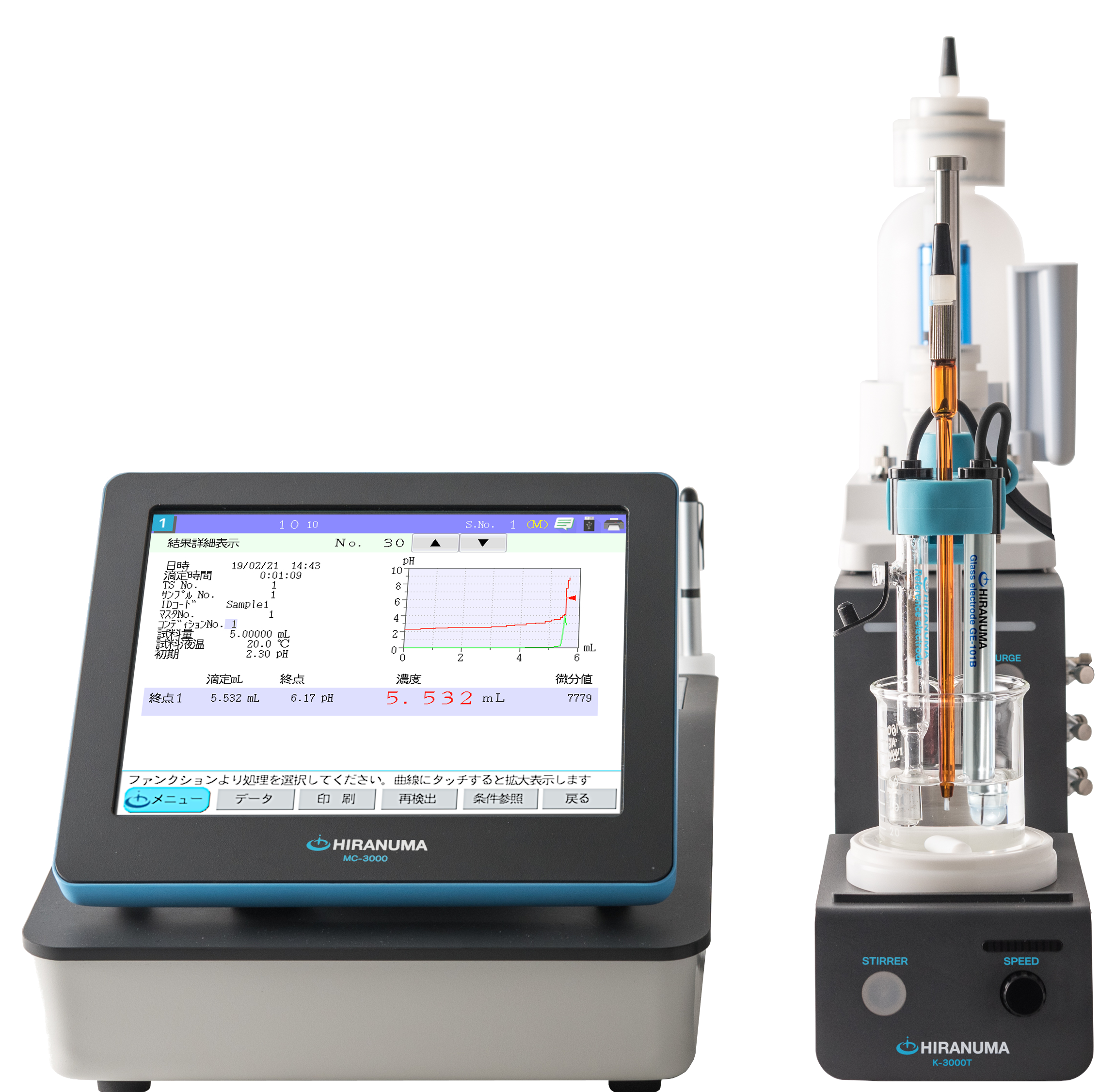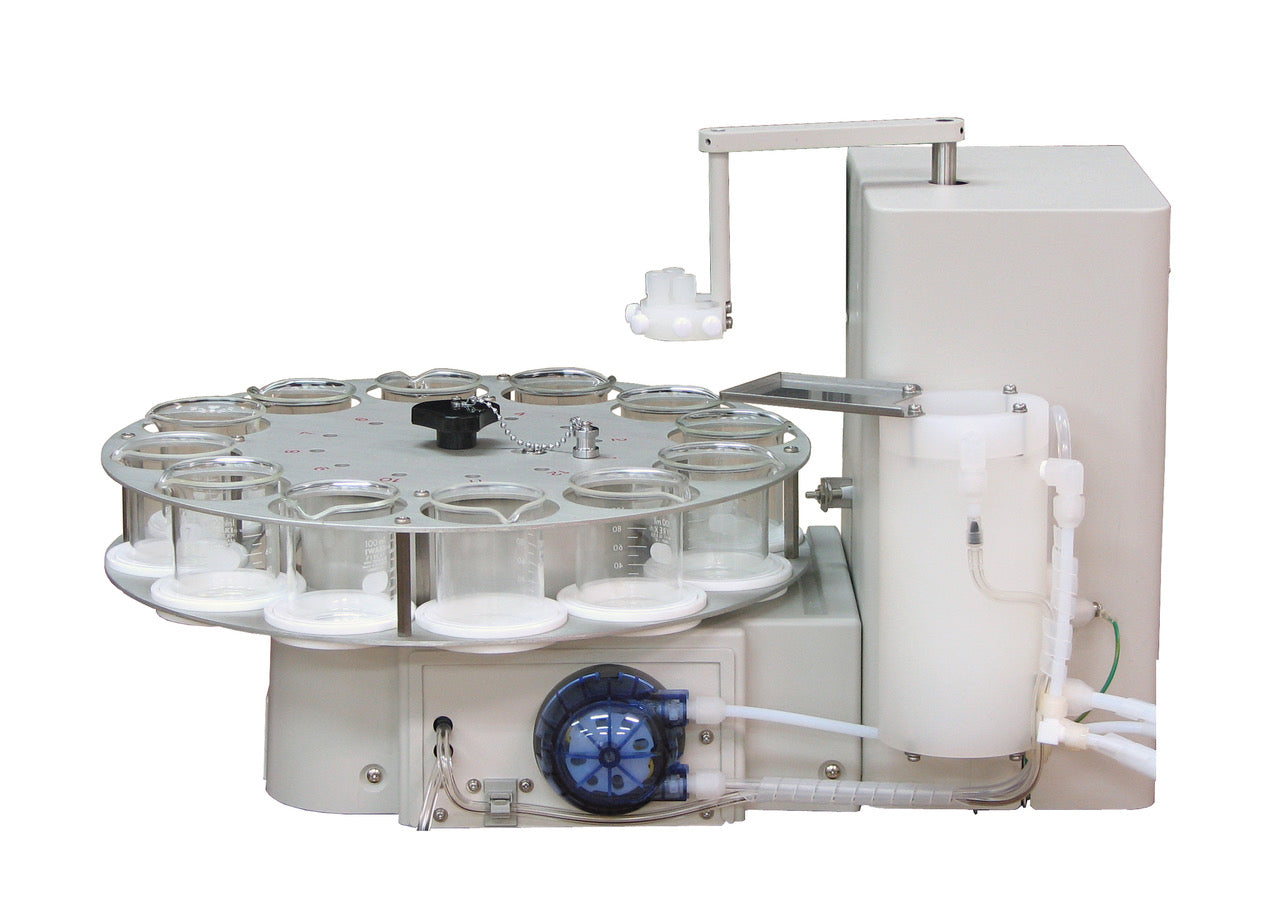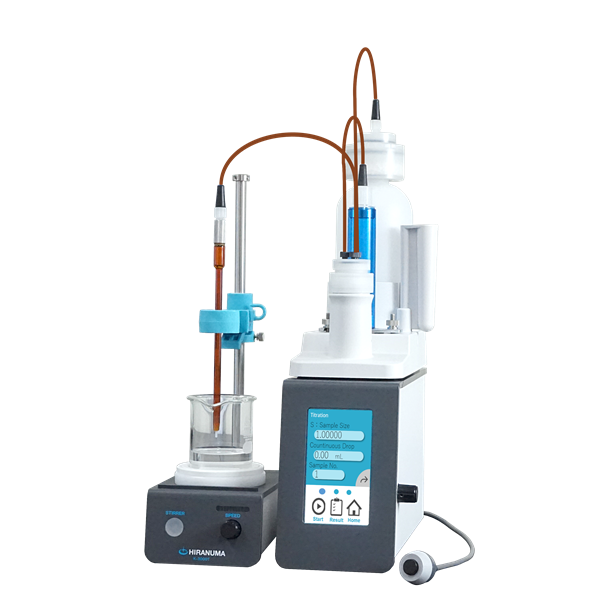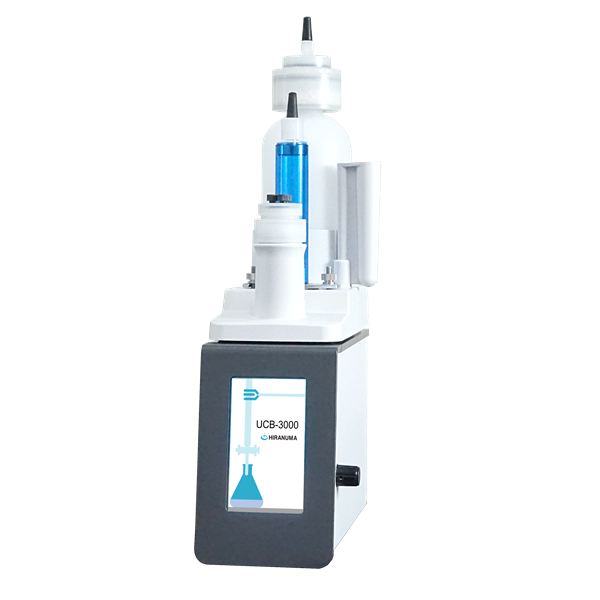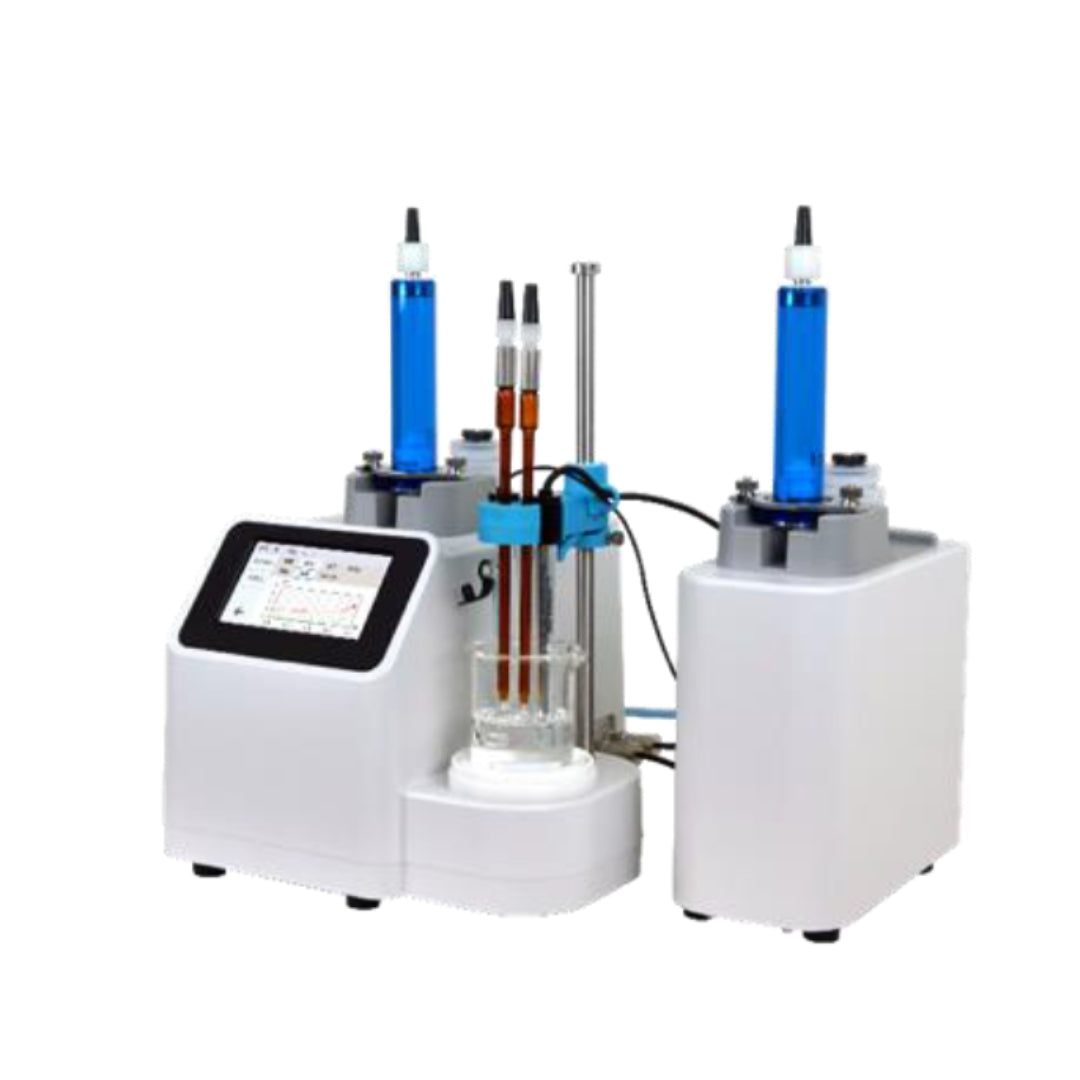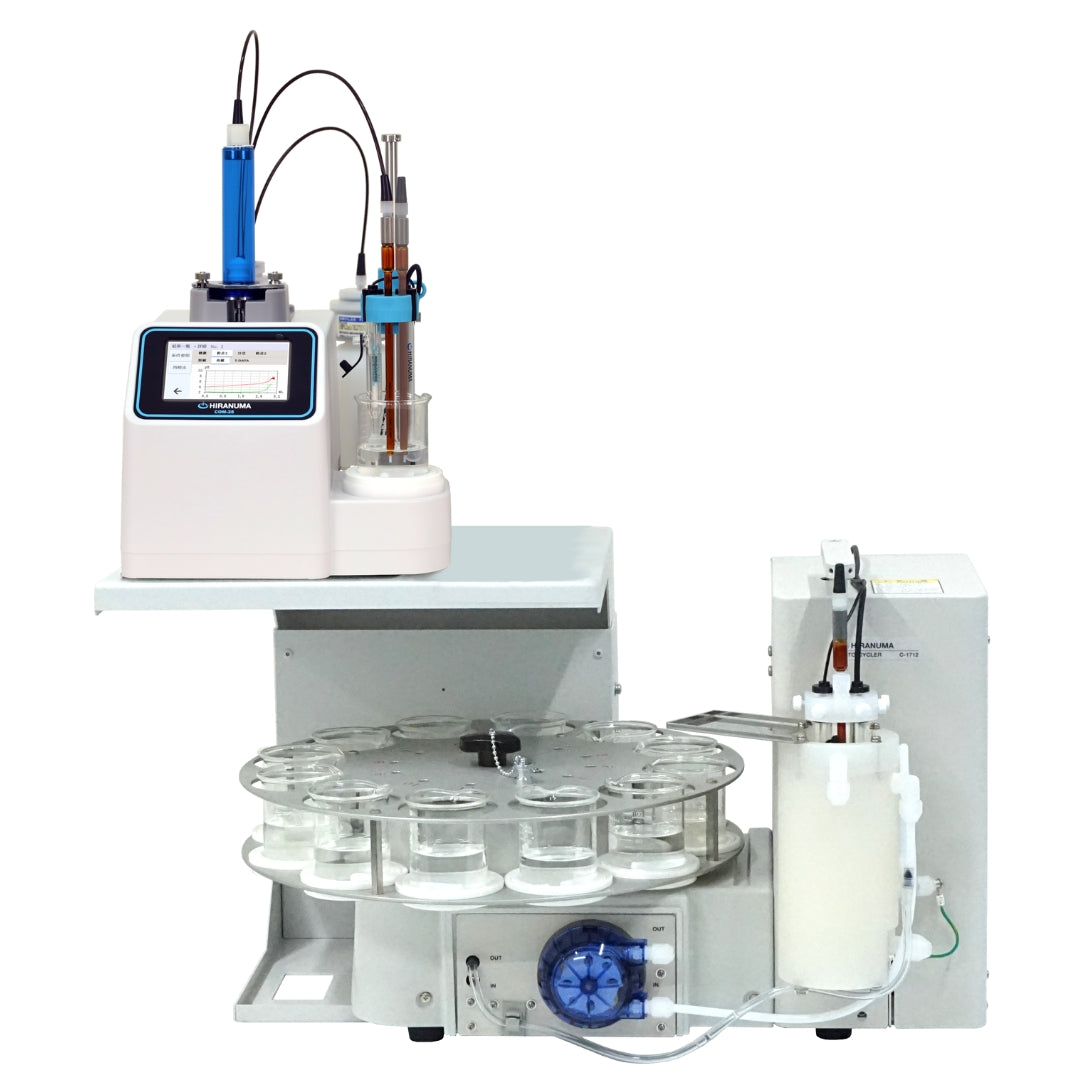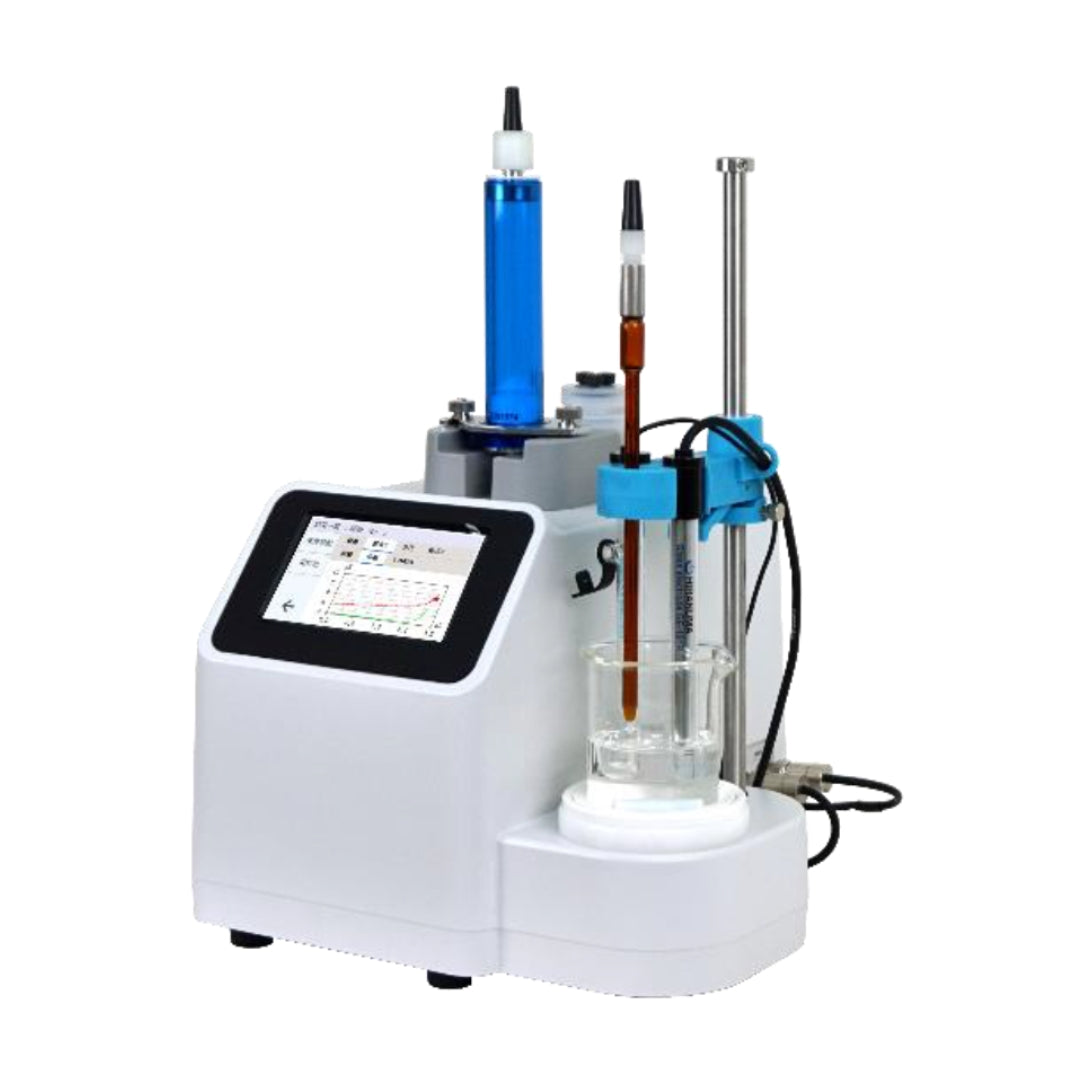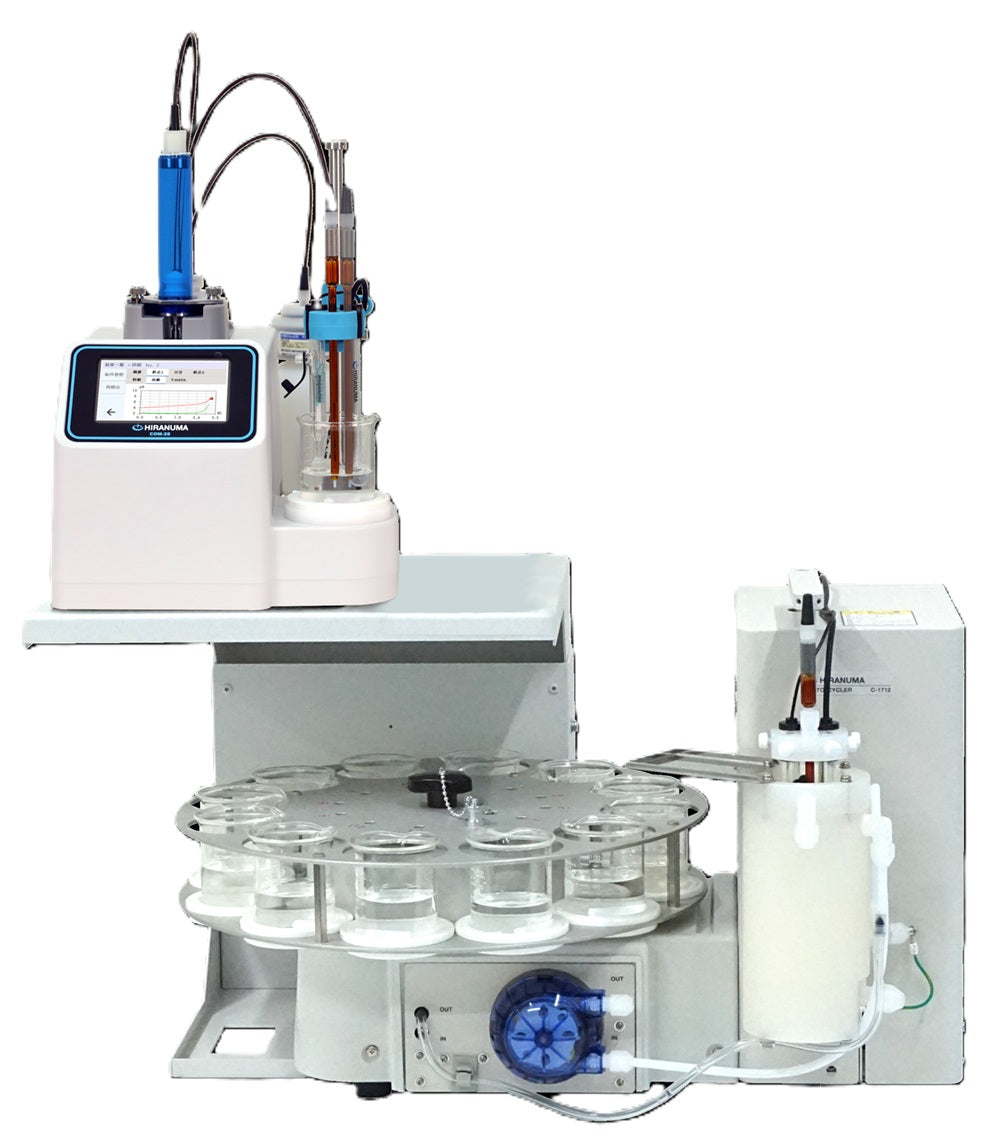| HIRANUMA APPLICATION DATA | Automatic Titrator | Data No. | H5 | Oct. 7,2022 |
| SODA PULP INDUSTRY | Determination of residual alkali in sodium hypochlorite |
1. Abstract
Sodium hypochlorite is produced by having sodium hydroxide absorb chlorine gas. Produced sodium hypochlorite contains sodium chloride generated by the degradation of hypochlorous acid.
This report introduces an example for the determination of residual alkali (sodium hydroxide, sodium carbonate) in the sodium hypochlorite with potentiometric titration. The procedure is described as follows: Add hydrogen peroxide to sodium hypochlorite to decompose the sodium hypochlorite (reaction (1)). Run neutralization titration with hydrochloric acid standard solution (reaction (2) ~ (4)). The pH reaches at around 8 on the reaction of (2) and (3). In the case of sodium carbonate, the sodium hydrogen carbonate generated on reaction (3) is continuously titrated with hydrochloride acid, and pH reaches to around 4 at the end point on the reaction (4). The reaction from (2) to (4) and related titration curve are illustrated in figure 1.
Titration volume for sodium hydroxide can be calculated by subtracting titration volume (b mL) of 2nd end point titration from titration volume (a+b mL) of 1st end point.
The concentration of sodium carbonate can be determined by titration volume of 2nd end point. Therefore sodium hydroxide and sodium carbonate can be determined separately with successive titration. Inflection point at around pH 11.5 is expected as the end point for sodium hydroxide, but the inflection point is unclear. Therefore it is not identified as the end point on this titration.
| NaClO + H₂O₂ → NaCl + H₂O + O₂ | ・・・(1) |
| NaOH + HCl → NaCl + H₂O | ・・・(2) |
| Na₂CO₃ + HCl → NaHCO₃ + NaCl | ・・・(3) |
| NaHCO₃ + HCl → NaCl + CO₂ + H₂O | ・・・(4) |

Figure 1 Neutralization titration curve for sodium hydroxide and sodium carbonate with hydrochloric acid
2. Configuration of instruments and Reagents
| (1) | Configuration of instruments | ||
| Main unit | : | Hiranuma Automatic Titrator COM series | |
| Electrodes | : | Glass electrode GE-101B Reference electrode RE-201Z *Instead of above electrode, the following electrodes are useable. ・GR-501B (Glass reference combination electrode)…Fixed sleeve type ・GR-511B (Glass reference combination electrode)…Moveable sleeve type |
|
| (2) | Reagents | ||
| Titrant | : | 0.2 mol/L Hydrochloric acid standard solution | |
| Additive solution | : | 1 mL of 30 % Hydrogen peroxide | |
3. Measurement procedure
| (1) | Dispense 2 mL of sample and weigh accurately. |
| (2) | Add 30 mL of DI water. |
| (3) | Add 1 mL of 30 % hydrogen peroxide to decompose the sodium hypochlorite. Please note that it reacts vigorously in this procedure. |
| (4) | Immerse the electrodes and titrate with 0.2 mol/L hydrochloric acid standard solution. |
4. Measurement conditions and results
Examples of titration conditions
(1) Measurement condition of sodium chloride and sodium carbonate
| Cndt No | 1 | |
| Method | Auto | |
| Buret No. | 1 | |
| Amp No. | 1 | |
| D. Unit | pH | |
| S-Timer | 60 | sec |
| C.P. mL | 0 | mL |
| T Timer | 0 | sec |
| D.P. mL | 0 | mL |
| End Sens | 700 | |
| Over mL | 0 | mL |
| Max Vol. | 20 | mL |
| Constant No. | 1 | |
| Size | 0 | g |
| Blank | 0 | mL |
| Molarity | 0.2 | mol/L |
| Factor | 1.004 | |
| K | 40 | |
| L | 0 | |
| Unit | % | |
| Formula | ||
| (VA-VB)*K*F*M/(S×10) | ||
| Decimal Places | 4 | |
|
Auto input Param.
|
None | |
| Mode No. | 5 | |
| Pre Int | 0 | sec |
| Del K | 5 | |
| Del Sens | 0 | mV |
| Int Time | 3 | sec |
| Int Sens | 3 | mV |
| Brt Speed | 2 | |
| Pulse | 40 | |
| 0.05 | mL | |
(2) Measurement condition of sodium carbonate
| Cndt No. | 2 | |
| Method | Auto | |
| Buret No. | 1 | |
| Amp No. | 1 | |
| D. Unit | pH | |
| S-Timer | 0 | sec |
| C.P. pH | 9 | pH |
| T Timer | 0 | sec |
| D.P. pH | 6 | pH |
| End Sens | 500 | |
| Over mL | 0.3 | mL |
| Max Vol. | 20 | mL |
| ConstantNo. | 2 | |
| Size | 0 | g |
| Blank | 0 | mL |
| Molarity | 0.2 | mol/L |
| Factor | 1.004 | |
| K | 105.99 | |
| L | 0 | |
| Unit | % | |
| Formula | ||
| (D-B)*K*F*M/(S×10) | ||
| Decimal Places | 4 | |
|
Auto input Param.
|
None | |
| Mode No. | 5 | |
| Pre Int | 0 | sec |
| Del K | 5 | |
| Del Sens | 0 | mV |
| Int time | 3 | sec |
| Int Sens | 3 | mV |
| Brt Speed | 2 | |
| Pulse | 40 | |
| 0.05 | mL | |
Connect condition of (1) and (2) for the titration.
Measurement results
Sodium Hydroxide
| Number of measurement |
Size (g) |
1st End point Titrant Volume(mL) |
Sodium Hydroxide (%) |
|---|---|---|---|
| 1 | 2.5456 | 6.770 | 1.6149 |
| 2 | 2.5288 | 6.723 | 1.6005 |
| 3 | 2.5144 | 6.673 | 1.5835 |
| Statistic calculation |
Avg. | 1.600 % | |
| SD | 0.016 % | ||
| RSD | 0.98 % | ||
Sodium Carbonate
| Number of measurement |
Size (g) |
2nd End point Titrant volume (mL) |
Sodium Carbonate (%) |
|---|---|---|---|
| 1 | 2.5456 | 1.652 | 1.3812 |
| 2 | 2.5288 | 1.684 | 1.4173 |
| 3 | 2.5144 | 1.716 | 1.4525 |
| Statistic calculation |
Average | 1.417 % | |
| Standard deviation | 0.036 % | ||
| Coefficient of variation | 2.52 % | ||
Examples of titration curves

5. Note
Since the residual sodium hypochlorite could cause measurement errors, the excess hydrogen peroxide should be added to decompose sodium hypochlorite completely.
Keywords: Sodium hypochlorite, Residual alkali, Sodium hydroxide, Sodium carbonate, Neutralization titration
*Some measurement would not be possible depending on optional configuration of system.


